Who is Fabian Hürzeler?
As FC St. Pauli continues to make waves in German football, much credit is attributed to the transformative impact of their head coach, Fabian Hürzeler.
Since assuming the helm in early 2023, 31 year old Hürzeler has orchestrated a defensive revolution within the team, reshaping their mindset and strategy to elevate their performance significantly.
This Fabian Hürzeler tactical analysis delves into Hürzeler’s defensive tactics, analysing the shifts in the team’s formation, pressing mechanisms, and overall defensive stability.
This analysis aims to uncover the nuances that have propelled FC St. Pauli to an unprecedented standing in the league under Hürzeler’s guidance.
Fabian Hürzeler Tactics
Under the stewardship of Fabian Hürzeler tactics, FC St. Pauli has undergone a pronounced transformation in their defensive resilience, marking a distinct departure from the trends observed during the tenure of his predecessor, Timo Schultz.
The impact of Hürzeler’s defensive tactics is most evident in the significant reduction in goals conceded by the team.
During Schultz’s reign, St. Pauli struggled defensively, conceding an average of 1.47 goals per game.
However, since Hürzeler assumed control in early 2023, there has been a remarkable improvement, with the team now conceding only 0.80 goals per game.
This defensive solidity can be attributed to strategic adjustments implemented by Hürzeler, such as a lower pressing height.
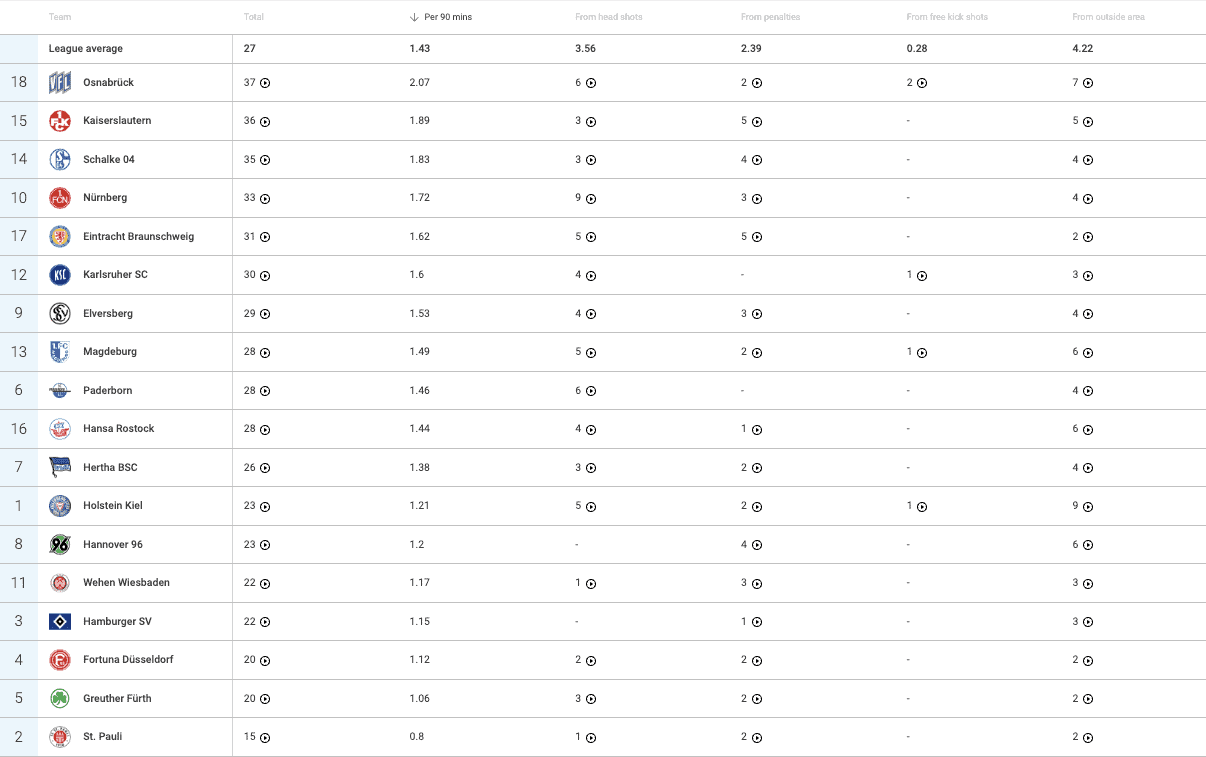
A noteworthy statistical shift is the increase in the PPDA (Passes Allowed per Defensive Action) value from 8.3 to 10.9 under Hürzeler’s guidance.
This rise indicates a deliberate tactical choice, allowing 2.6 more passes in the attacking and midfield thirds compared to Schultz’s tenure.
This allows them to be more compact, limiting the opposition’s progression while still having the opportunity to jump into a high press in some cases.
The defensive system is very much zonal, usually structured in a fixed 5-2-3 or 5-4-1, depending on the height.
The front three leads the line, usually sitting at the same height as the opposition’s midfield. The midfield two will sit just behind the three, forming a pentagon shape of sorts.
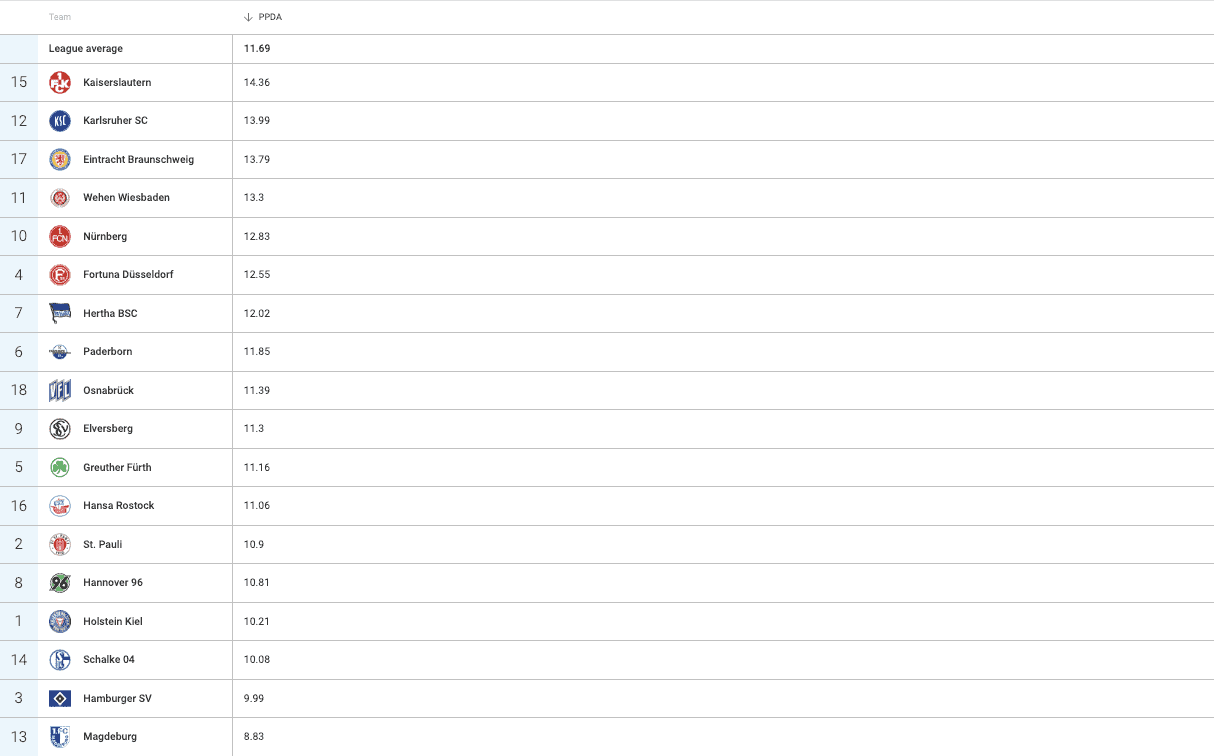
Despite a lower challenge intensity, evident in fewer defensive duels (49.82 per 90), St. Pauli maintains a dominant style of play, boasting the second-highest possession rate in the league at 57.3%.
The tangible results of these defensive adjustments are reflected in St. Pauli’s impressive league standing. Currently occupying the second position, they remain the only team in the league yet to suffer a defeat, with a commendable record of 8 wins and nine draws.
Hürzeler’s impact on St. Pauli’s defensive resilience has not only elevated the team’s performance but has also solidified their standing as a force to be reckoned with in the league.
Fabian Hürzeler Defensive Formation
Under the tactical guidance of Fabian Hürzeler, FC St. Pauli has embraced a defensive setup that reflects both organisation and intensity, contributing significantly to the team’s improved defensive stability.
Deploying a 5-2-3 formation during the defensive phase, the structure becomes evident when the opponent has time to build up play.
However, the distinctive feature of Hürzeler’s approach is the immediate and intense pressing employed by St. Pauli right after losing possession.
This proactive counter-pressing not only disrupts the opponent’s rhythm but also serves as a strategic advantage by allowing the team to establish its essential defensive organisation.
In terms of defensive structure, the team transitions into a 5-2-3 formation, reminiscent of the defensive behaviour observed in Eintracht Frankfurt under Oliver Glasner, a key influence on Hürzeler.
The five-man defensive line creates a solid foundation, with the two midfielders engaging in man-to-man situations, forming a compact block alongside the attacking back three.
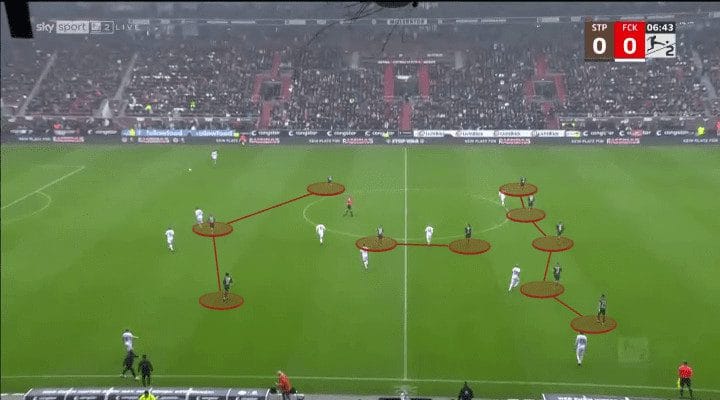
This defensive setup effectively restricts the opponent’s central progression, strategically creating space for passes to the opposing full-backs.
This deliberate tactic triggers the second phase of defensive behaviour, showcasing Hürzeler’s meticulous planning to limit the opponent’s options and reinforce defensive solidity.
Hürzeler’s tactics emphasise a seamless transition between intense pressing and a structured defensive formation, showcasing an astute defensive mindset that has significantly bolstered FC St. Pauli’s defensive capabilities.
Fabian Hürzeler Pressing
Fabian Hürzeler’s tactical ingenuity in pressing has played a pivotal role in FC St. Pauli’s enhanced defensive stability, showcasing a strategic approach that disrupts opponents and stifles their build-up play.
When the opposing team directs the ball to the wings, FC St. Pauli’s defensive shape undergoes a dynamic transformation.
The five-man block adjusts as the attacking wingers drop deeper and wider, forming a situational 5-4-1. Simultaneously, the centre-forward shifts towards the side, aligning with the centre-back close to the ball.
This swift reorganisation allows St. Pauli to quickly generate an outnumbered situation near the ball, applying pressure through various channels.
In scenarios where the opponent opts for lateral passes to the wings, FC St. Pauli seamlessly transitions into a 5-4-1 shape.
The central midfielders remain man-oriented, and the centre-forward presses towards the ball side.
This defensive structure effectively closes the space between players, with the wingers and central midfielders maintaining a man-oriented approach. The centre-back, exhibiting diligence, closes down passing lanes.
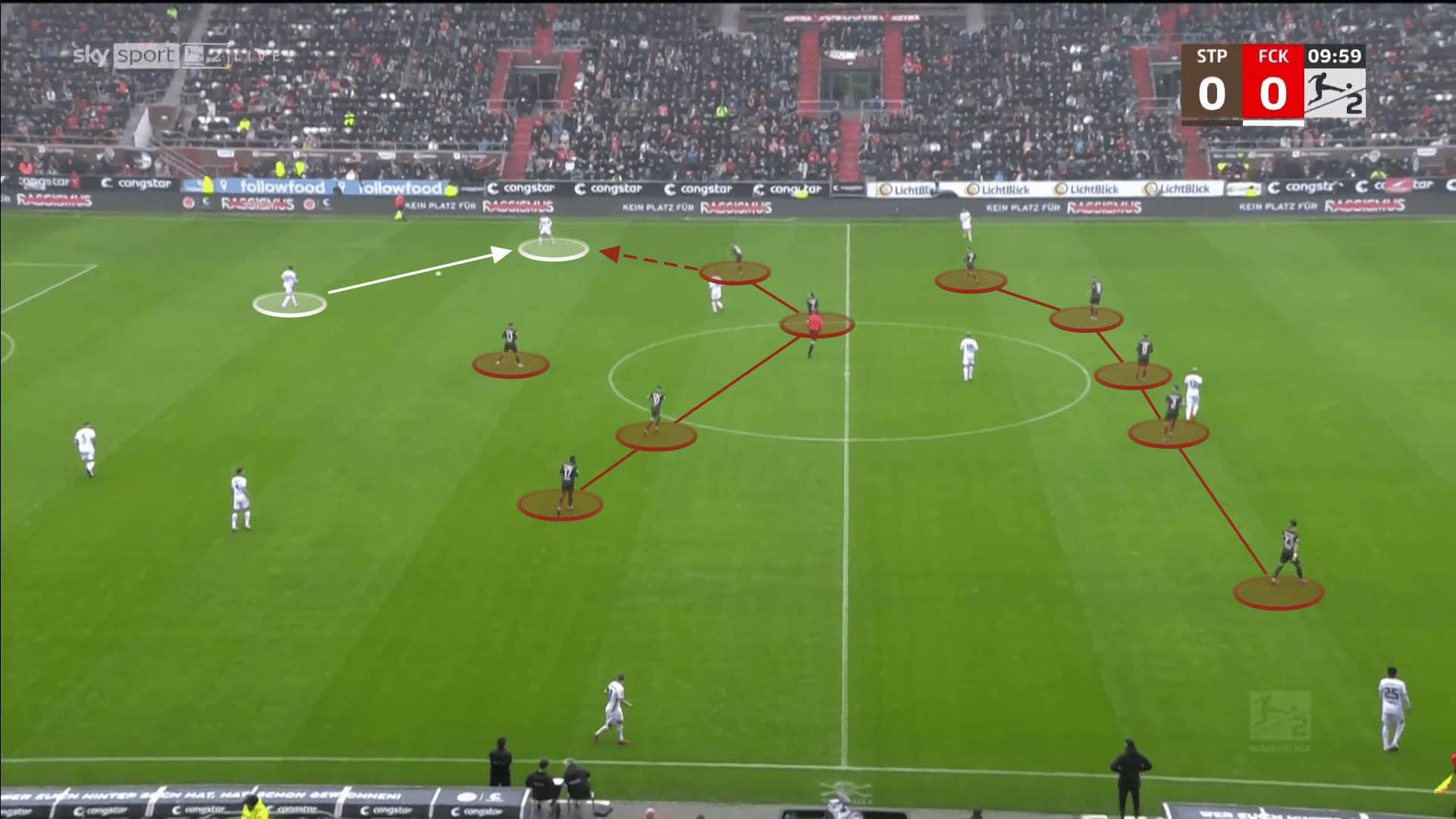
The pressing trigger for St. Pauli is often the lateral pass between the opponent’s centre-backs. From the 5-4-1 formation, the wing-10s surge forward, and the centre-forward applies pressure on the ball-carrying centre-back, limiting passing angles.
This coordinated pressure and strategic positioning deny the opponent space and access to passing options.
Directed towards one side, St. Pauli’s pressing strategy converges pressure from all angles near the ball. Winning the ball prompts diagonal runs in the last line, creating spaces away from the ball.
Wing-backs intelligently exploit these spaces, with a number ten strategically positioned to capitalise on the dynamic offensive transition, epitomising Hürzeler’s multifaceted approach to pressing and defensive stability.
Fabian Hürzeler Attacking Pressing
When the opponent endeavours to build up play in a controlled manner, FC St. Pauli’s midfield and attacking units coordinate to form a five-man block.
This strategic alignment effectively restricts central passing lanes, making it challenging for the opposition to navigate through the centre of the pitch.
Upon the opponent playing the ball to the flanks, FC St. Pauli’s defensive structure seamlessly transitions into a back four, shaping up in a 5-4-1 formation.
This defensive evolution is designed to tighten the space available to the opposition, creating a compact defensive block.
Notably, this transition often occurs when the opposing players find themselves in a backward movement, a less ideal scenario for controlled build-up play.
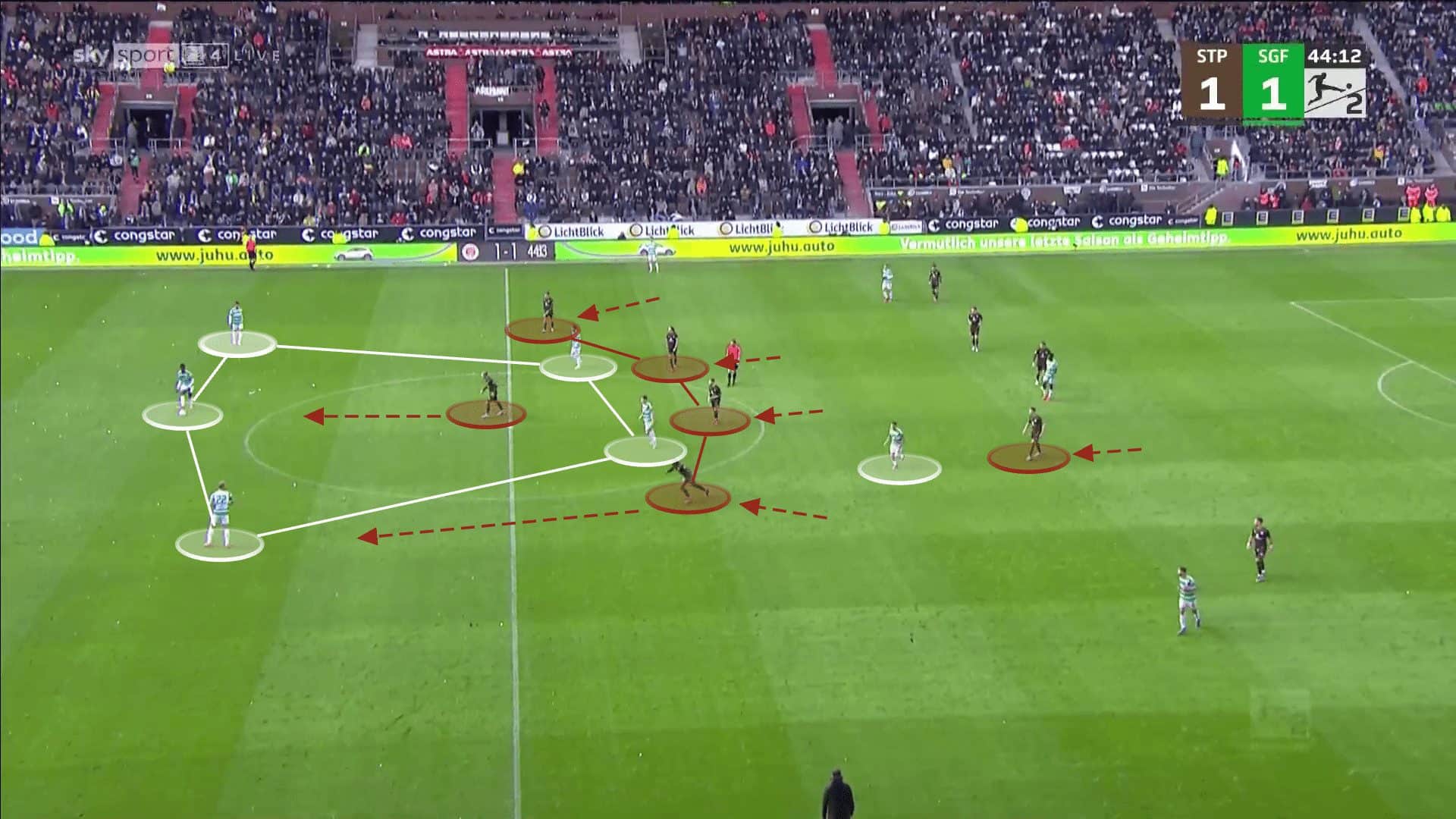
In the attacking pressing phase, players are tasked with directly engaging and challenging their counterparts, with even the centre-back close to the ball advancing forward.
Depending on the opponent’s formation, the centre-back away from the ball may also join the pressing efforts.
This refined and aggressive high-pressing system employed by Hürzeler has played a pivotal role in destabilising opponents, disrupting their build-up play, and ultimately contributing to FC St. Pauli’s enhanced defensive stability in crucial moments of the game.
Fabian Hürzeler Advantages & Disadvantages
Fabian Hürzeler’s defensive system at FC St. Pauli brings forth both advantages and potential disadvantages, showcasing the team’s adaptability and strategies to mitigate shortcomings.
The pressing system allows FC St. Pauli to maintain a superior number in the last defensive line, making it challenging for opponents to break through.
It is effective in winning the ball directly from the opponent, particularly when the opposition resorts to playing long balls.
Once FC St. Pauli establishes its basic defensive organisation, the team becomes highly difficult to break down, contributing to overall defensive stability.
The team exhibits a remarkable willingness to work defensively, which is evident in the high number of intensive runs, showcasing their commitment to defensive duties.
However, the system may face challenges when opposing teams swiftly shift to the far side of the pitch, potentially breaking FC St. Pauli’s pressing structure.
If opposing teams can play and assert themselves in the back despite pressure, FC St. Pauli’s pressing may be breached. To address these challenges, the team strongly emphasises defensive transition phases, with players displaying a high willingness to switch quickly after losing possession.
The team’s dynamism and intensity during defensive transitions are crucial, resembling the defensive work seen in successful teams like Atlético Madrid under Diego Simeone.
Hürzeler’s management has instilled mental resilience in the team, ensuring that players remain committed to defensive tasks despite inevitable ball losses and demonstrate a strong collective mindset.
While the system has its vulnerabilities, FC St. Pauli’s effective defensive organisation, strategic adaptations, and mental resilience under Hürzeler’s leadership have contributed to the team’s remarkable defensive stability and success in the league.
Conclusion
Fabian Hürzeler style of play on FC St. Pauli’s defensive improvement cannot be overstated.
The systematic changes he introduced, from the adjusted pressing heights to the meticulous defensive structure, have propelled the team to new heights in terms of defensive stability.
The statistics reflect a remarkable transformation, with a significant decrease in goals conceded and an undefeated streak that underscores the effectiveness of Hürzeler’s tactics.
The defensive transitions and pressing triggers implemented by the coach have become integral components of the team’s success.
As FC St. Pauli continues to assert itself as a force to be reckoned with, Hürzeler’s defensive blueprint serves as a beacon of success and a testament to the impact of tactical acumen on a team’s performance.





Comments